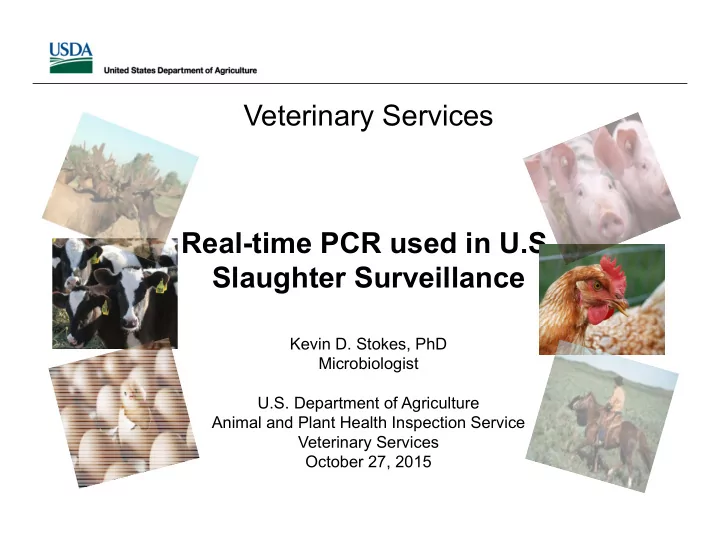

Veterinary Services Real-time PCR used in U.S. Slaughter Surveillance Kevin D. Stokes, PhD Microbiologist U.S. Department of Agriculture Animal and Plant Health Inspection Service Veterinary Services October 27, 2015
Objectives • Review historical workflow • Introduce current workflow • Report performance of assay on slaughter surveillance samples • Discuss control setup and performance of controls • Discuss performance of assay in known affected herds 2
Historical workflow: partial parallel testing 60% Slaughter surveillance granuloma identified Borate sample Not Collect: Etiology cultured Borate sample for determined by PCR/Culture Histopathology Borate Results and sample Report Formalin sample for cultured ≤ 8 wks Histopathology 40% Results and Report ≤ 2 days 1 day 8 weeks 3
Culture/Histology performance % FFPE MTBC Histology % No. No. M. bovis PCR results false submissions M. bovis Year submitted No. confirmed +/total (%) negative cultured isolated 2009 7362 23 82.6% 17/22 (77.3%) 2 40.3% 21 2010 8584 17 58.8% 7/15 (46.7%) 0 42.3% 10 4
Disadvantage of culture Culture Slow ( ≤ 8 wks) High cost Low throughput (max 24 samples/day/person) Results after histology released 5
Advantages of PCR Culture PCR Fast ( ≤ 24 hrs) Slow ( ≤ 8 wks) Low cost High cost High throughput (max Low throughput (max 24 75 samples/day) samples/day/person) Results prior to histology Results after histology release released 6
Current workflow: full parallel testing Slaughter surveillance PCR of Report M. bovis Report granuloma identified borate PCR specific M. bovis sample results PCR results Collect: Borate sample for Compare PCR/Culture Compare Etiology Formalin sample for determined by Histopathology Histopathology Results and Borate Results and Report sample Report ≤ 2 days cultured ≤ 8 wks 1 day 8 weeks 7
Development & Implementation • Development May – Dec. 2013 • Validation started December of 2013 • Start parallel testing with culture January 2014 • Real-time PCR replaced culture in April, 2014 after 2000+ tests 8
Performance of real-time assay in slaughter surveillance Side-by-side Pre-validation Testing w/ culture Post-validation Dec. 2013 Jan. - Apr. 2014 Apr. 2014 - May 2015 0.998 0.992 Specificity ND (95% CI) (0.994, 1.00) (0.990, 0.994) 0.96 1.00 Sensitivity ND (95% CI) (0.89, 0.99) (0.91, 1.00) No. of samples Hist +, PCR + 74 3 38* (+2) Hist -, PCR - 3 1732 6077 Hist +, PCR - 3 0 0 Hist -, PCR + 0 3 47* (-2) Total 80 1738 6162 9
Control setup Types of controls: 1) Negative tissue extraction control added every 5 samples thru 20 samples, then every 10 2) TB tissue extraction control added every 5 samples thru 20 samples, then every 10 3) One M. bovis tissue extraction control added to each plate 4) Every sample and control has an internal extraction control Full 96-well plate would have 75 samples, 10 negative controls, 10 TB controls, and 1 M. bovis control. 10
Control Daily Average 11
Post Validation Ct Results TB 1081-3 1081-3 L3 1081-3 L3 BCG Control Control False Pos. True Pos. True Pos. BCG Cont. BCG Cont. Subset Subset 12
Using the real-time PCR in affected herds • 3 herds in Michigan (2) and Texas (1) • 340 samples were parallel tested by either histology, culture or both. 13
Performance in known affected herds MTBC Histology or Histology or culture + culture - Total Sensitivity PCR + 297 1 298 0.97 PCR - 9 32 41 (95% CI 0.94, 0.99) Total 306 33 339 Histology Histology M. bovis or culture + or culture - Total Sensitivity PCR + 289 0 289 0.95 PCR - 14 31 45 (95% CI 0.92, 0.97) Total 303 31 334 14
Limits of the Assay • Open system- High risk of laboratory contamination – Cross contaminations likely will occur, plan controls and their locations in plates well – Amplicons (PCR product) can build up in facility with daily use • Requires highly trained molecular technicians and a workflow that protects against contamination • Requires lesioned tissue • Very small tissue amounts can be tested (0.3 g) with PCR vs 50 g for culture 15
Conclusion USDA is now using real-time PCR in place of culture to screen submissions for routine slaughter surveillance – Assay Sensitivity >97%, Specificity >99% – Allows us to resolve discrepant results prior to the release of the histology report. – Allows us to screen 100% of the samples with two independent tests, which greatly reduces error. 16
Acknowledgements NVSL Philip Dykema Kevin Stokes Nadine Beckwith Patrick Camp David Farrell Robin Swanson Lizhe Xu Deborah Vickers Hannah Wilson Doris Bravo Bruce Thomsen James Mungin CVB Suelee Robbe-Austerman Monica M. Reising 17
Questions?
Recommend
More recommend